With the long, cruel summer finally over and a refreshing chill in the air, my thoughts are turning towards the glories of Taiwan’s hot springs. However, not so much to the developed bath houses and resorts of Yangmingshan, Beitou and Wulai. (although those are very nice in their own way), as to the nation’s wild hot springs.
It’s still a couple of months too early to safely consider visiting most of the finest hot springs — Hayouxi (哈尤溪溫泉), Huisun (惠蓀溫泉) and Lulu (轆轆溫泉) — because it’s still technically rainy season in the southern half of Taiwan, and rivers will either be flowing too high to negotiate, or be subject to sudden and dangerous flash floods as thunderstorms hit. This is, however, a great time to visit the cluster of springs in the northeastern county of Yilan.
In November the summertime risk of heavy afternoon showers has gone, while the northeast monsoon fronts (which make Yilan wet and miserable for much of the winter) have yet to strengthen.
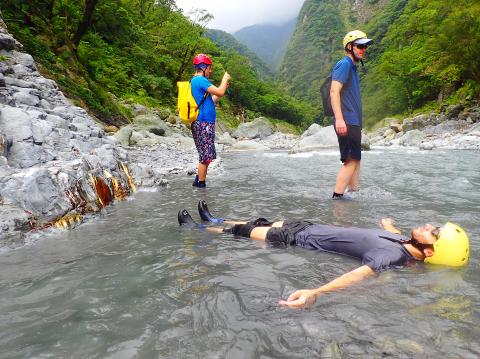
Photo: Richard Saunders
PRISTINE POOLS
Yilan County is rich in hot springs. While several famous ones at Jiaosi (礁溪) and Renze (仁澤) near Taipingshan, have long been tapped to provide water for commercial resorts, several remain natural, untouched and utterly beautiful.
A couple of easy-to-reach springs lie just a stone’s throw from each other on Highway 7, southwest of Yilan City. Fanfan (梵梵溫泉) and Paiguxi (排骨溪溫泉) hot springs are both just a short stroll from the road. Unfortunately, Fanfan is very popular these days, especially with four-wheel drive aficionados, who park their motorized monstrosities on the riverbed right beside the spring. Paiguxi, although still blissfully natural, is only big enough for a couple of bathers at any one time.
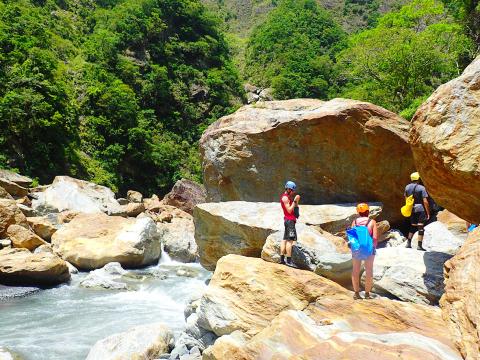
Photo: Richard Saunders
A bigger and more important group lies around the town of Nanao (南澳), one of the main settlements along the magnificent Suhua Highway (Highway No. 9). A remote trio lie deep in the mountains on tributaries of Hoping Creek, between Nanao and Taipingshan, but requires a strenuous three-day camping trip. Easier to reach are the four hot spring sources along Nanao Creek.
Flowing out of the mountains to the northwest, the creek passes right through the town before reaching the ocean just north of a beautiful stretch of cliff-bound coastline known as Mystery Coast (神秘海岸). The first two spring sources are easily accessible, thanks to a road that follows the first 6km or 7km of the river gorge. Bihou (碧候) and Area Four (四區) hot springs lie beside the road and have both been developed, with water piped into unsightly artificial pools. Wild hot spring lovers should motor straight past these without a second glance, park near Area Four Hot Spring and follow the track further in the direction of the blissfully untouched Laka Hot Spring (拉卡溫泉).
Walk ahead along the track through the woods parallel to the broad riverbed, which comes to an abrupt end after 500m. Clamber down to the riverbed and start walking upstream towards the wide gorge opening up ahead.
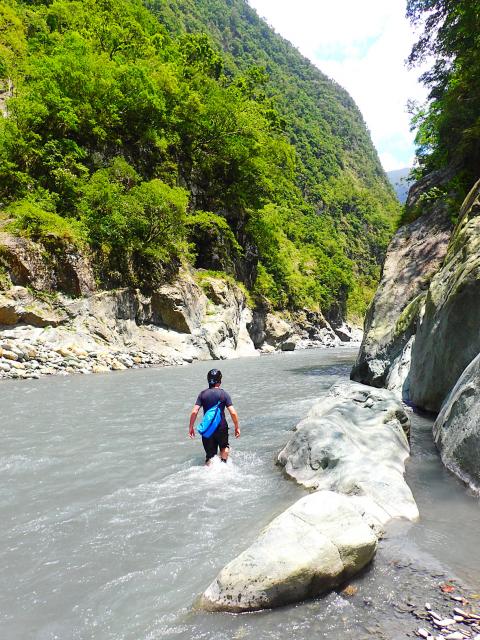
Photo: Richard Saunders
Presently the gorge narrows and the going becomes rougher — the only way is to clamber up, over and occasionally under huge boulders (some nearly as big as a house) washed down by past typhoons. In a few places the sides of the gorge squeeze the river between low cliffs of grey marble, and these stretches are only passable when the river is fairly low.
MINERAL WATER
About 90 minutes (or 3km) from the end of the road, the source will be obvious in rocks on the right bank of the river. The powerful source of hot spring water seeps out of a series of cracks in a low sill of rock about 20m in length. If the river is fairly low, the water at the base of the rock will be the temperature of a hot bath. At the far end, a small stream of scalding hot water (too hot to even stick your toe in) runs through the gravel and into the river, leaving a strip of brightly colored minerals as it flows.
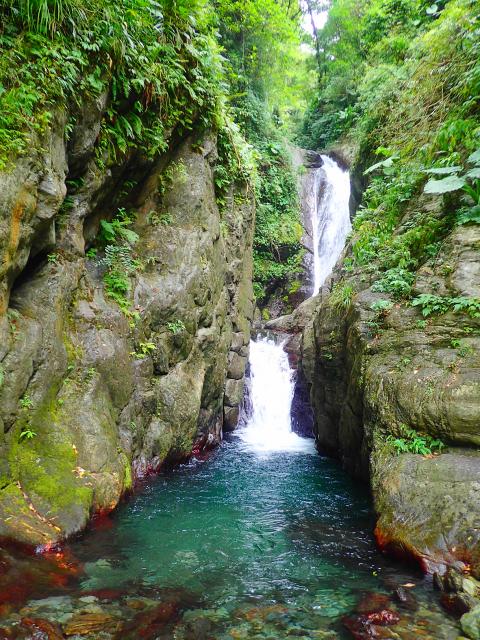
Photo: Richard Saunders
Several kilometers upstream from Laka lies Yading Hot Spring (芽丁溫泉), but it’s normally approached from a completely different direction via a long mountain road beginning near Dongshan (冬山).
If time and weather conditions allow though, do walk upstream from Laka Hot Spring a little further (20 minutes) and your reward, on a side stream to the right after a sharp left-hand bend, is a beautiful small waterfall: a double plunge leaping into a deep pool of pure, bright blue-green water.
Richard Saunders is a classical pianist and writer who has lived in Taiwan since 1993. He’s the founder of a local hiking group, Taipei Hikers, and is the author of six books about Taiwan, including Taiwan 101 and Taipei Escapes. Visit his Web site at www.taiwanoffthebeatentrack.com.
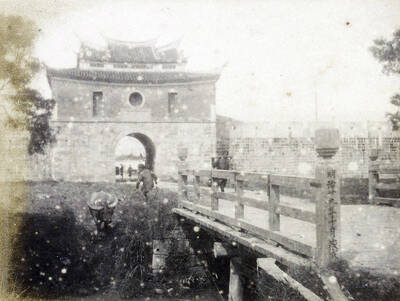
June 9 to June 15 A photo of two men riding trendy high-wheel Penny-Farthing bicycles past a Qing Dynasty gate aptly captures the essence of Taipei in 1897 — a newly colonized city on the cusp of great change. The Japanese began making significant modifications to the cityscape in 1899, tearing down Qing-era structures, widening boulevards and installing Western-style infrastructure and buildings. The photographer, Minosuke Imamura, only spent a year in Taiwan as a cartographer for the governor-general’s office, but he left behind a treasure trove of 130 images showing life at the onset of Japanese rule, spanning July 1897 to

One of the most important gripes that Taiwanese have about the Democratic Progressive Party (DPP) is that it has failed to deliver concretely on higher wages, housing prices and other bread-and-butter issues. The parallel complaint is that the DPP cares only about glamor issues, such as removing markers of Chinese Nationalist Party (KMT) colonialism by renaming them, or what the KMT codes as “de-Sinification.” Once again, as a critical election looms, the DPP is presenting evidence for that charge. The KMT was quick to jump on the recent proposal of the Ministry of the Interior (MOI) to rename roads that symbolize

On the evening of June 1, Control Yuan Secretary-General Lee Chun-yi (李俊俋) apologized and resigned in disgrace. His crime was instructing his driver to use a Control Yuan vehicle to transport his dog to a pet grooming salon. The Control Yuan is the government branch that investigates, audits and impeaches government officials for, among other things, misuse of government funds, so his misuse of a government vehicle was highly inappropriate. If this story were told to anyone living in the golden era of swaggering gangsters, flashy nouveau riche businessmen, and corrupt “black gold” politics of the 1980s and 1990s, they would have laughed.

It was just before 6am on a sunny November morning and I could hardly contain my excitement as I arrived at the wharf where I would catch the boat to one of Penghu’s most difficult-to-access islands, a trip that had been on my list for nearly a decade. Little did I know, my dream would soon be crushed. Unsure about which boat was heading to Huayu (花嶼), I found someone who appeared to be a local and asked if this was the right place to wait. “Oh, the boat to Huayu’s been canceled today,” she told me. I couldn’t believe my ears. Surely,